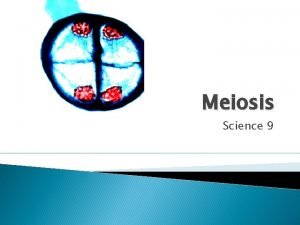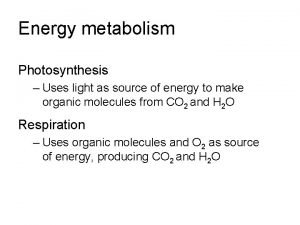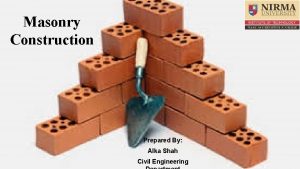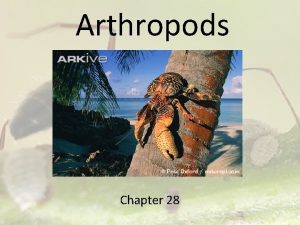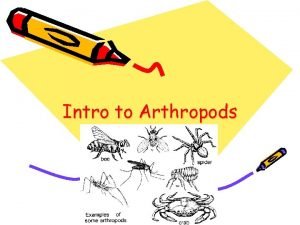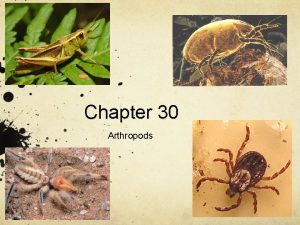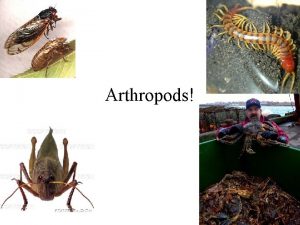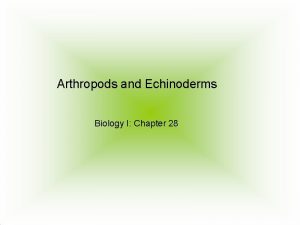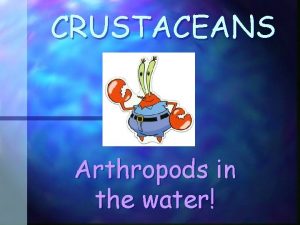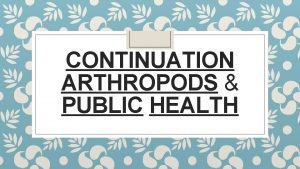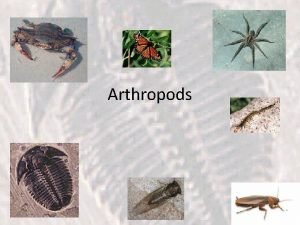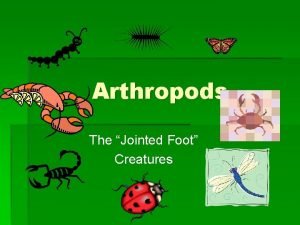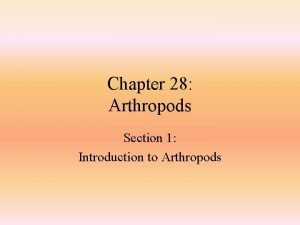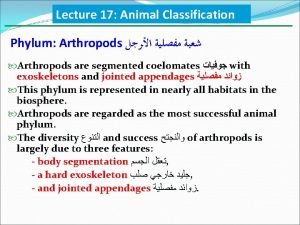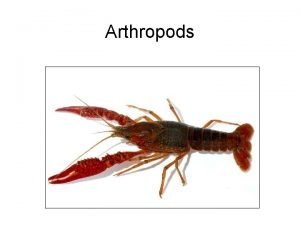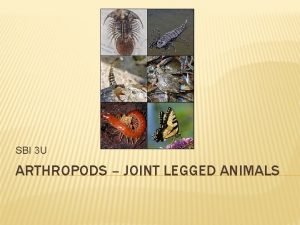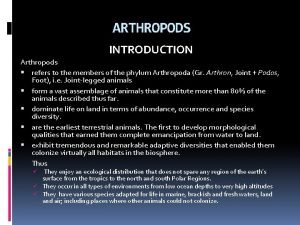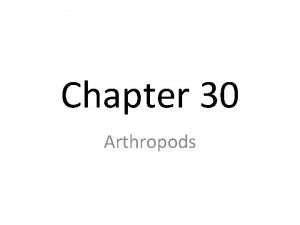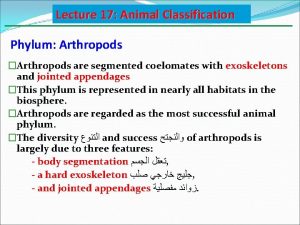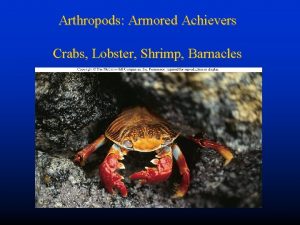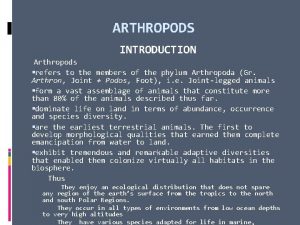Ch 24 A Closer Look at Arthropods 24



















- Slides: 19

Ch 24 A Closer Look at Arthropods 24. 1 Arthropod Diversity • Arthropods characteristics – invertebrates – exoskeleton (cuticle) made of chitin – jointed appendages (paired) – segmented body parts

• Arthropod Groups – Trilobites • extinct, bottom feeders – Crustaceans • live in oceans, freshwater streams, and on land – Chelicerates • specialized daggerlike mouthparts – Insects • most live on land, have six legs – Myriapods • long bodies and many pairs of legs

• Movement – Joints are made of stiff and flexible cuticle to allow movement. • The exoskeleton is made of many layers of chitin. – hard material that protects the body – must be shed in order to grow • Molting 1. Secrete new layer cuticle under exoskeleton 2. Enzyme weakens old exoskeleton, crawl out of it 3. New exoskeleton filled with fluid/larger than before, will harden

• Internal/External Functions • Arthropods have an open circulatory system. • Sensory organs such as antennae are made of modified cuticle. • Most arthropods have compound eyes.

• Arthropod Diversity – The oldest fossils are of trilobites that date back 540 million years. • The evolutionary relationship between arthropods and other invertebrates remains under question. – body segmentation similar to annelids – molecular evidence suggests segmentation is analogous development • Velvet worms and water bears are considered the closest relatives of arthropods.

24. 2 Crustaceans • Crustaceans evolved as marine arthropods • Crustaceans share several common features. – two distinct body sections, cephalothorax and abdomen – one pair of appendages per segment – two pairs of antennae – exoskeleton – carapace

• Appendages include claws, antennae, walking legs, swimmerets, and mandibles. • Crustacean appendages are used for a variety of functions. – collecting and manipulating food – attracting females – protection

• Crustaceans vary in both anatomy and structure. – Decapods such as lobsters and crabs have ten legs. • Barnacles are sessile filter feeders wrapped in a hard shell. • Isopods such as pill bugs have flattened bodies and seven pairs of legs. • Tongue worms are parasites found in a host’s lungs or nasal passages.

24. 3 Arachnids • Arachnids are spiders and their relatives • Arachnids are the largest group of chelicerates – Lack antennae – Have 6 paired appendages – 4 pairs of walking legs – Fanglike mouthparts chelicerae – Appendages pedipalps grasp prey – 2 body sections: cephalothorax and abdomen

• There are three major groups of chelicerates. – horseshoe crabs – sea spiders – Arachnids

• Arachnids are a group of chelicerates that live on land. – eight legs – fanglike pincers that inject venom – silk glands fangs poison gland spinnerets • Arachnids have four different adaptations that reduce water loss. – waterproof cuticle – book lungs – Malpighian tubules – spiracles

• Diversity of Archanids: – All spiders make silk and produce venom. – Spiders make up half of the more than 60, 000 known arachnid species. – Arachnids also include mites, ticks, chiggers, and scorpions

24. 4 Insect Adaptations • Insects are in nearly every ecological niche. • Insects have a body with three parts. – head – thorax – Abdomen

• Some insects live independently, others live in social colonies • In incomplete metamorphosis, insects look like miniature adults when they hatch. • There are three life stages of incomplete metamorphosis. – larva – nymph – adult

• There are three life stages of complete metamorphosis. – egg – larva – pupa – adult

• Evolution to life on land – The evolution of flight occurred in insects 400 million years ago. – An insect’s mouth parts are adaptations related to its specialized diet. • • sucking mouth parts chewing mouthparts

24. 5 Arthropods and Humans • Arthropods interact with humans. • Many arthropods are herbivores that eat plants humans also depend on. – Arthropods cause millions of dollars of crop damage. – Insecticides have unwanted side effects.

• Scientists have developed safer insecticide alternatives. – arthropod-specific insecticides – integrated pest management (IPM) – genetically modified crops

• Vectors are organisms that carry disease from one host to another. • Disease spread by arthropods have serious effects on human populations. – Bubonic plague is caused by a bacterium carried by fleas. – Yellow fever is caused by a virus carried by mosquitoes. – Malaria is caused by a protozoan parasite carried by mosquitoes. – West Nile virus is caused by a virus carried by mosquitoes.
 Look down and to the left
Look down and to the left Function of meiosis
Function of meiosis Look closer see me
Look closer see me Ch 7 a closer look: energy metabolism pathways
Ch 7 a closer look: energy metabolism pathways Chapter 7 a closer look energy metabolism pathways
Chapter 7 a closer look energy metabolism pathways A closer look at thanksgiving
A closer look at thanksgiving Care closer to home
Care closer to home Lexair collet closer
Lexair collet closer Squint junction in brick masonry
Squint junction in brick masonry Care closer to home
Care closer to home One day closer quotes
One day closer quotes Friend that sticks closer than a brother esv
Friend that sticks closer than a brother esv Amperage can be described as
Amperage can be described as Racking back brickwork
Racking back brickwork Care closer to home
Care closer to home Co-destiny relationship
Co-destiny relationship Jesus is my rock and he rolls my blues away lyrics
Jesus is my rock and he rolls my blues away lyrics Sample compound sentences
Sample compound sentences Creeping closer meaning
Creeping closer meaning God is closer than you think
God is closer than you think

